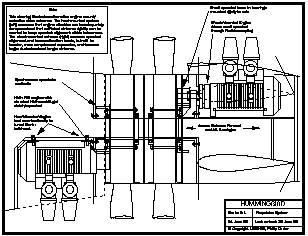
Propulsion Concepts
Ducted Propellers
Counter-Rotation
The Hummingbird Propulsion System
All competitive aerobatic aircraft are overpowered in cruise. They require powerful engines and large-diameter propellers to create thrust for rapid acceleration and climb at relatively low airspeeds, where propellers are least efficient.
A primary design goal for Hummingbird is to increase propulsive efficiency at low and zero airspeeds while simultaneously decreasing aircraft weight and size. Rather than simply adding more power and larger propellers (with the accompanying spiral of weight and speed), the whole question of propulsion has been re-examined. This involves two major components: engines and propellers.
Engines
[Note that the following was written circa 1998. Since then, engine technologies have moved on, along with current thinking. 2-cycles are not presently in the picture. But the basic principles regarding engine selection still apply.]
The Status Quo
Most current aerobatic aircraft use conventional air cooled, 4-cycle aircraft engines, usually Lycoming 0-360’s or 0-540’s of 200-300 hp. The Russian Sukhois and Yaks use 4-cycle radials of 360-400 hp. Unlimited aerobatics punishes these engines with extreme bearing and crankshaft loads, an intermittent oil supply, and rapidly varying temperatures. Consequently, in this application they survive for but a fraction of their expected life in the more benign applications for which they were designed.
The 2-Cycle Alternative
Modern 2-cycle engines offer many desirable qualities for efficient aerobatic flight. The most obvious, of course, is their high power-to-weight ratios, which far exceed those of 4-cycle aircraft engines. 2-cycle engines offer further advantages that are not so obvious. Oil can be delivered with the fuel, ensuring constant lubrication at any attitude, without the cost and weight of an inverted oil system. Similarly, the commonly used diaphragm carburetors or fuel injectors function at any attitude without additional systems. Modern 2-cycle engines have less rotating mass and are far more compact than their 4-cycle cousins, allowing greater flexibility in engine location and orientation.
Wankel and orbital engines have potential to compete with the 2-cycle’s weight and size, but they are not as developed or as available. Presently, therefore, 2-cycle engines are a natural part of the solution in the quest for higher thrust-to-weight ratios.
The Hirth 2-Cycles
Some of the best current 2-cycle technology is to be found in engines built by Hirth Motoren of Germany. Until recently the most powerful Hirth engine has been the F30. The tuned version of this 4 cylinder, 1042 cc, air cooled, horizontally opposed engine produces 124 hp at 6200 rpm, weighs 109 lb complete with carburetors, starter, alternator, dual ignition system, and tuned exhaust system, and measures 23" wide by 15" long by 12" high.
Fuel consumption specifics of the F30 are similar to those of 4-cycle aircraft engines. Modern metallurgical advances have taken these engines to acceptable levels of reliability (assuming they are properly cooled, fueled, and maintained), while costs to buy and overhaul are but a fraction of the costs for conventional aircraft engines.
It is important to note that the achilles heel of conventional 2-cycle engines—hot or cold seizures due to rapid and/or uneven heating and cooling—has been largely solved in the Hirth engines through the use of Nikasil cylinders and hypereutectic pistons. These advanced technologies combined with liquid-cooling should practically eliminate seizures relating to cooling deficiencies, even in our demanding aerobatic application.
Within the Ultralight community, doubts exist about the Hirth’s reliability. Upon investigation, it appears that much of this “bad press” goes back to the failed BD-5, which used an earlier generation of Hirth engine (less than successfully), and to early teething problems with the modern generation of Hirths. Contemporary models cannot be compared to these earlier versions. People flying behind Hirth engines generally speak highly of them; any problems can usually be traced back to improper cooling, fueling, or maintenance. The Hirth F30 reliably powers at least two light helicopters, one of which is certified under the European JARs.
Despite the fact that the F30 is one of the highest-output 2-cycle aircraft engines currently available, it provides only about half the power required for competitive aerobatic flight. Overcoming this problem is deceptively obvious: Use two engines. While conventional configurations would render this unworkable for an aerobatic aircraft, we shall see from the following discussion that the use of two engines, configured in a completely original manner, permits the creation of an elegantly simple propulsion system of unparalleled efficiency and symmetry.
Recreational Power Engineering offers a Web site with more information on the Hirth engines.
Forthcoming Hirth Engines
It is reported that two new Hirth engines are to become available: an air-cooled 1200 cc machine of 140 hp, and a liquid cooled version of 150 hp. While Hummingbird has thus far been designed around the 124 hp F30, the new liquid-cooled engine will likely be the engine of choice. Despite increasing empty weight somewhat, it will improve power-to-weight ratios and head off what could be sticky cooling problems with the air-cooled F30 in our buried application.
What about turbines?
Turbines are a popular solution in the quest for higher thrust-to-weight ratios. This is the “obvious” choice which, upon closer analysis, does not necessarily fit the bill.
Turbines do have two great strengths: reliability and power-to-weight ratio. Alongside these strengths must be considered the many caveats:
- Cost. Turbines are very expensive to buy and maintain, and they have relatively high fuel consumption specifics.
- Controllability. Turbines take time to spool up. Aerobatics demands rapidly varying power levels, which turbines may have trouble keeping up with.
- Heat. The high temperatures in and around turbine engines can be problematic with buried engine configurations utilizing composite structures.
- Exhaust. What to do with the hot exhaust coming from the forward engine?
- Power transmission. The mechanical systems required to reduce RPM from a rapidly spinning turbine to a slow-turning propeller can destroy any weight advantage that the turbine might offer.
- Legality. It is my understanding that turbines are illegal for aerobatic competition.
In short, while turbines may some day become available which would be perfect for Hummingbird, presently 2-cycles and Wankels are more practical.
Ducted Propellers
For a given power input, one may increase static thrust by increasing propeller diameter. The extreme of this principle is demonstrated in the helicopter, with a very large propeller—the rotor—which provides enough static thrust to hover. Obviously, though, a helicopter will not make a good aerobatic airplane. In practice, propeller diameter is limited by structural, gyroscopic, tip speed, and ground clearance considerations.
Another way to increase the thrust of a propeller is to place it inside a shroud, yielding what is often called a “ducted fan.” At low airspeeds, a properly designed shroud (duct) can increase thrust significantly over a free propeller of the same diameter. Thus, static and low-speed thrust can be increased without any increase in power or propeller diameter. This is obviously a very desirable quality for an aerobatic airplane.
A further benefit of ducted propellers is that the duct aligns the incoming airstream perpendicular to the propeller disk. This is particularly useful for an aerobatic airplane which constantly demands high thrust levels while at high angles of attack.
Ducted propeller systems are not in common use for the following reasons.
- Duct drag. At high speeds, where most aircraft are designed to operate, the drag of the duct overcomes any propulsive benefits.
- Structural weight. The duct is a complex form which is difficult to build with conventional materials. This can lead to significant weight penalties.
The penalty of duct drag is less significant for an aerobatic airplane, which spends much of its time at relatively low airspeeds. A slight reduction in top speed is a small price to pay for significant gains in static and low-speed thrust. Moreover, duct drag penalties can be minimized if the duct is designed to double as a lifting surface, thus allowing a smaller wing. This, of course, forces the duct to be located near the aircraft center of gravity.
The structural weight of the duct is also a concern. This compromise can be optimized by configuring the aircraft so that the duct becomes a central structural component, bracing the wing in torsion and bending, and carrying fuselage loads around centrally-located propellers. It will be shown that this is relatively straightforward to accomplish.
Counter-Rotating Propellers
Further gains in propulsive efficiency can be achieved through the use of counter-rotating propellers. At low and zero airspeeds, when a relatively small mass of air is moving through the propeller disk, a propeller imparts a significant amount of rotational (tangential) flow to the air mass. This rotational flow is wasted energy. A second propeller, close to the first and turning in the opposite direction, can take advantage of this rotating air, turning it into useful thrust. The air mass coming out of a well-designed counter-rotating propeller system has no rotational motion; the air mass is accelerated axially only, and uniformly across the disk, meaning that induced energy losses are minimized and propulsive efficiency is optimized.
A secondary advantage of a counter-rotating propeller system is its symmetry. All else being equal, an aircraft with counter-rotating propellers and engines will behave symmetrically on all axes. There will be no asymmetrical torque effects.
The Hummingbird Propulsion System
Hummingbird’s propulsion system integrates these three aforementioned elements:
- High power-to-weight ratio 2-cycle or Wankel engines.
- A duct or shroud.
- Counter-rotating propellers.
These three features combine to create a propulsion system of unprecedented thrust-to-weight ratio, without requiring huge engines or very large propellers. Furthermore, the system is propulsively symmetrical, and the duct doubles as a structural brace and as a lifting surface (see later).
Two engines are used for the following reasons:
- No suitable engines exist in the 200-300 hp class, which is the approximate power required. Engines do exist in the 100-150 hp class.
- The use of two engines simplifies the drive train. If each engine is mounted at 180 degrees to the other and drives its own propeller, the two engine/propeller combinations remain mechanically independent systems, virtually identical but rotating in opposite directions. This results in a symmetrical propulsion system.
- Safety. During low altitude, low and zero airspeed maneuvers, one engine/propeller can maintain up to 70% thrust and generate airflow over the tail surfaces, greatly enhancing recovery in the case of an engine failure.
- A single large engine forward of the duct and propellers would move the CG too far forward.
This propulsion concept promises to make possible the design goal of sustained, fully controlled, hovering flight.



© Copyright 1992-2009 Philip Carter
